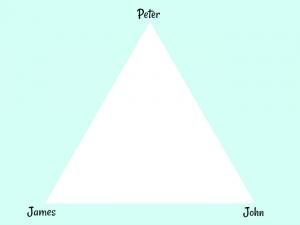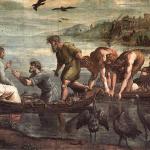During a three day training I attended, the number three shouted at me from every concept and nearly every page—restrictions lasting 3 years, 30-year commitments, 3 contract segments. One mnemonic device provided was “Three 3s and a B-I-N.”
I’ve been thinking about triangles over the past few weeks, and three’s ubiquitousness reminded me to revisit a train of thought.
“All was divided into three.” ~Homer
“A whole is that which has a beginning, middle and end.”-Aristotle
Three, to me, represents wholeness, completion, wisdom, thoroughness, the transformation of duality to completeness, a presidency.
A triangle then is an approximation of an ideal.
Starting with the triangle as the unit of all subjective operations our conception of it is based upon our knowledge of the objective unit: we proceed from a knowledge of the part to a concept of the whole — or unknown unit. To do this we transmute the objective to the subjective and raise the power of the numeral to infinity.
When thus raised to the power of the infinite unit the triangle is our symbol for truth. As a symbol for the whole of truth, it holds the key to all science, to all wisdom, and its study leads with certain steps to and through that door wherein the mystery of life ceases to be a problem, and becomes revelation.
An understanding of the triangle depends upon the analysis of the objective unit, the arithmetic definition of which is “a single thing.” The first idea we get from this single thing is wholeness; nothing can be added to it nor subtracted from it without impairing its unity as a single thing. Second: Its unity involves the idea that it can be separated, that it consists of parts. Third: These parts hold certain unchanging relationship to each other, then as related to its wholeness it has unity, as related to its separableness it has diversity, and as related to its unchangeableness it has identity; unity, diversity and identity, are the essential qualities of every “single thing,” or every unit, and the equilateral triangle is the symbol that manifests these three qualities in unity. ~Lydia Bell
James and John
When I try to understand things, I doodle them out. I drew a triangle and thought of applicable gospel topics. I added Peter, James, and John to the points of a triangle.

I felt led to look up meanings of names, though familiar with them.
I started with John. It’s Ioannes in Greek. John means “Jehovah is gracious” or “The Lord has been gracious.” John is my dad’s first name, but it’s become even more significant to me because of its place in the endowment.
In Greek, James is Iakóbos, Jacob. Jacob means “supplanter, to supersede another especially by force or treachery, to eradicate and supply a substitute, especially by reason of superior excellence or power. Put out of a usual or proper place of another. Implies a filling of a place once occupied, lost, destroyed, or no longer usable or adequate.”
Following Jacob through to its root word aqeb, I discovered the name’s root is heel or foot. “Heel,” of course, brought to mind God’s cursing of Satan in the Garden of Eden—”And I will put enmity between thee and the woman, and between thy seed and her seed; it shall bruise thy head, and thou shalt bruise his heel.”
This jives with the story of Patriarch Jacob who was born immediately after Esau, holding his brother’s heel. Though I love the name Jacob, I’ve always wondered why Isaac would name his son “supplanter.” It seemed so weird to me and had a negative connotation because I generally think of Satan as a supplanter.
But two very preeminent leaders carry the name. Why? For the first time, I saw the name as indicative of one who would bruise the serpent’s head with his heel and supply a substitute by reason of superior power to fill a place lost, destroyed, or no longer usable.
The meanings of James and John, in parallel lists next to each other, shocked me. One one triangle tip, I had “supplanter, heel.” On the other triangle tip, I had “Jehovah is gracious.”
On one hand, I saw the Lord’s grace juxtaposed a malevolent supplanter. Opposition. The gospel story in a sentence.
On the other hand, I saw the Lord’s grace added to the substitution of one by another with greater power. Atonement. The gospel story in a sentence.
And then I believed a triangle was the teacher of wholeness and truth. In a moment of greater clarity, doctrinal truth became more cohesive and complete.
Again from Lydia Bell, “The first idea we get from this single thing is wholeness; nothing can be added to it nor subtracted from it without impairing its unity as a single thing. Second: Its unity involves the idea that it can be separated, that it consists of parts. Third: These parts hold certain unchanging relationship to each other….”
Wholeness, unity, unchanging relationship to each other.
The second half of this train of thought brings Peter into the mix in the post 3-Peter, James, and John as a Triangle.













